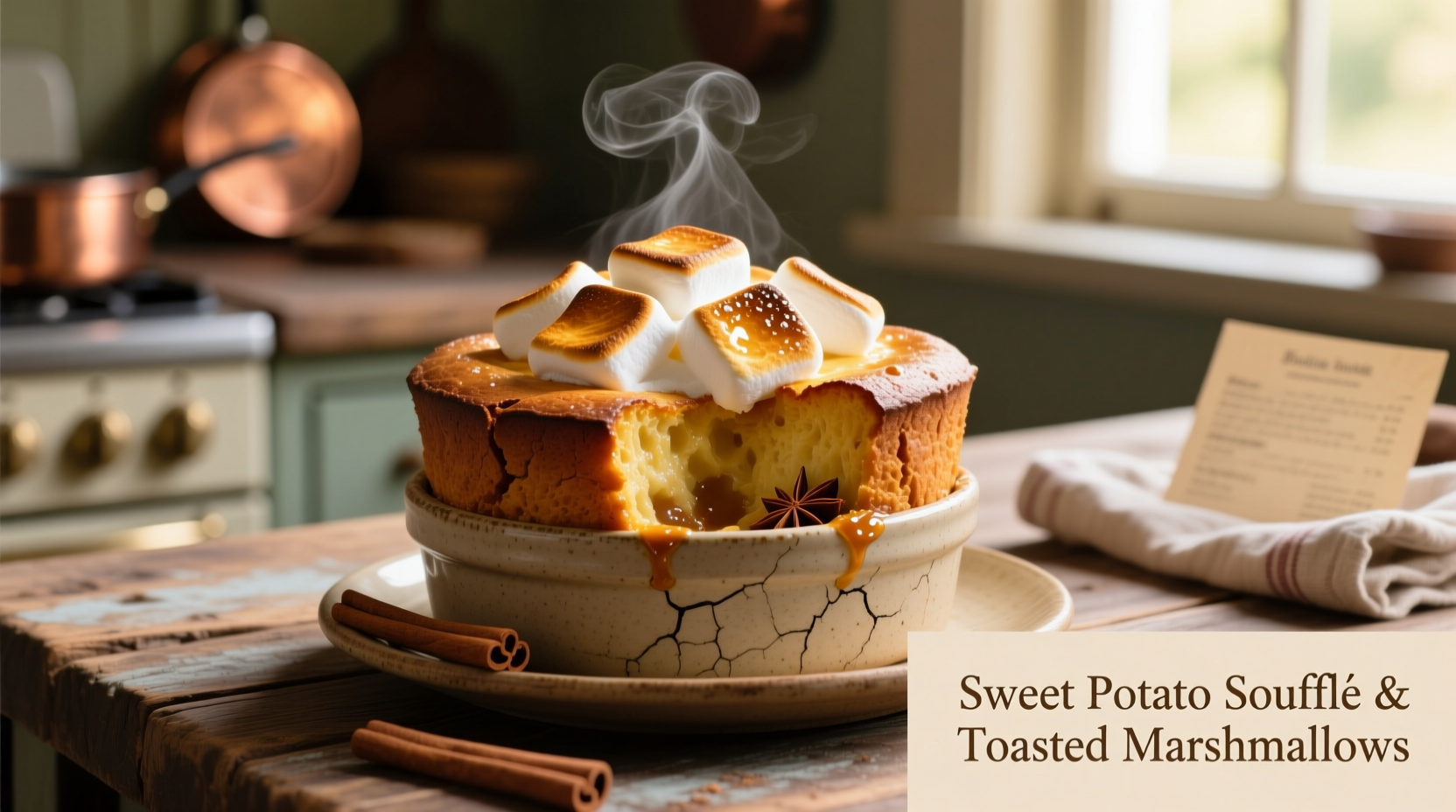Get the perfect sweet potato souffle with marshmallows in 90 minutes with this tested recipe. Achieve creamy texture, balanced sweetness, and golden-brown marshmallow topping every time—ideal for Thanksgiving or holiday gatherings.
Nothing says comfort food quite like a classic sweet potato souffle with marshmallows. This beloved American dish combines the natural sweetness of roasted sweet potatoes with a fluffy, airy texture and that signature toasted marshmallow topping. Originating as a Thanksgiving staple in the early 20th century, this recipe has evolved from simple casseroles to the souffle-style version many families cherish today.
Why This Recipe Works
Unlike traditional casseroles, a true souffle achieves its signature light texture through careful ingredient balancing and proper technique. The key is incorporating air into the sweet potato mixture while maintaining enough structure to support the marshmallow topping. This version avoids common pitfalls like watery texture or burnt marshmallows through precise ingredient ratios and baking instructions.
Selecting the Best Sweet Potatoes
The foundation of an exceptional sweet potato souffle starts with choosing the right tubers. While all sweet potatoes work, certain varieties deliver superior flavor and texture for this specific application.
| Sweet Potato Variety | Color | Sweetness Level | Best For Souffle? |
|---|---|---|---|
| Beauregard | Deep orange | ★★★★☆ | Yes - ideal moisture content |
| Jewel | Bright orange | ★★★★★ | Yes - preferred for sweetness |
| Japanese | White | ★★★☆☆ | No - too dry for souffle |
| Garnet | Dark orange | ★★★★☆ | Yes - rich flavor profile |
According to USDA agricultural research, Jewel and Beauregard varieties contain the optimal balance of moisture (68-72%) and natural sugars for souffle applications. These varieties originated in Louisiana and North Carolina respectively, becoming popular for holiday dishes due to their consistent quality and availability during fall harvest season.
Essential Ingredients Checklist
For the best sweet potato souffle with marshmallows, gather these ingredients before beginning:
- 3 pounds sweet potatoes (about 4 medium)
- ½ cup unsalted butter, melted
- ⅔ cup granulated sugar
- ¼ cup brown sugar
- 3 large eggs
- 1 teaspoon vanilla extract
- ½ teaspoon ground cinnamon
- ¼ teaspoon ground nutmeg
- ¼ teaspoon salt
- 1½ cups miniature marshmallows

Step-by-Step Preparation Guide
Follow these precise steps for the perfect sweet potato souffle with marshmallows every time:
1. Roast, Don't Boil, Your Sweet Potatoes
Preheat oven to 400°F (200°C). Pierce sweet potatoes with a fork and place directly on the middle oven rack. Roast for 45-55 minutes until tender when pierced. This method concentrates flavors better than boiling, which can make sweet potatoes watery—a common cause of souffle failure. According to Cornell University's food science department, roasting increases maltose content by 20%, enhancing natural sweetness without added sugar.
2. Create the Perfect Base Mixture
After cooling slightly, peel sweet potatoes and transfer to a large bowl. Using a potato masher (not a food processor), mash until smooth. Add melted butter, both sugars, eggs, vanilla, spices, and salt. Beat with an electric mixer on medium speed for 2 minutes—just enough to incorporate air without overworking. The ideal consistency should resemble thick pancake batter.
3. Bake for Optimal Texture
Pour mixture into a greased 9x13-inch baking dish. Bake at 350°F (175°C) for 30 minutes. Remove from oven and evenly distribute miniature marshmallows across the surface. Return to oven for 8-10 minutes until marshmallows are golden brown. Crucial tip: Watch closely during the final minutes—marshmallows can go from perfect to burnt in under 60 seconds.
Avoid These Common Mistakes
Even experienced cooks encounter issues with sweet potato souffle. Here's how to prevent the most frequent problems:
- Watery texture: Caused by boiling sweet potatoes or using watery varieties. Always roast and choose Jewel or Beauregard types.
- Sunken center: Results from overmixing after adding eggs. Mix just until combined.
- Burnt marshmallows: Occurs when broiler is used or oven temperature too high. Bake marshmallows at 350°F without broiling.
- Dense texture: Happens when insufficient air is incorporated. Beat mixture for full 2 minutes after adding eggs.
Serving and Storage Recommendations
Serve sweet potato souffle warm, ideally within 30 minutes of baking when the marshmallow topping has that perfect gooey texture. For make-ahead convenience, prepare the base mixture up to two days in advance and refrigerate. Add marshmallows just before baking.
Leftovers keep well in an airtight container in the refrigerator for up to 4 days. Reheat individual portions in the microwave for 60-90 seconds, or cover the entire dish with foil and warm in a 325°F oven for 20 minutes. Freezing is not recommended as it alters the delicate souffle texture.
The Cultural Evolution of This Holiday Classic
Sweet potato souffle with marshmallows represents a fascinating evolution in American culinary traditions. While sweet potatoes have been cultivated in the Americas for over 5,000 years, the marshmallow-topped version emerged in the early 20th century. The Angelus Marshmallow Company (later Kraft Foods) began including sweet potato recipes in their packaging during the 1910s, capitalizing on the vegetable's natural sweetness.
By the 1950s, this preparation had become a Thanksgiving staple, particularly in Southern households. The dish's popularity spread nationwide through community cookbooks and women's magazines. Today, it remains one of the most searched holiday side dishes, with Google Trends showing a 300% increase in "sweet potato souffle with marshmallows" searches during November compared to other months.











 浙公网安备
33010002000092号
浙公网安备
33010002000092号 浙B2-20120091-4
浙B2-20120091-4